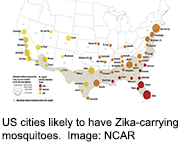
An outbreak of the mosquito-borne Zika virus in the United States could be very costly, a new study warns.
“This is a threat that has not gone away. Zika is still spreading silently and we are just now approaching mosquito season in the United States, which has the potential of significantly increasing the spread,” said study leader Dr. Bruce Lee. He is an associate professor in the department of international health at Johns Hopkins University’s Bloomberg School of Public Health.
“There’s still a lot we don’t know about the virus, but it is becoming clear that more resources will be needed to protect public health. Understanding what a Zika epidemic might look like, however, can really help us with planning and policy making as we prepare,” Lee said in a Hopkins news release.
In the study, computer models of outbreaks in Florida, Georgia, Alabama, Mississippi, Louisiana and Texas suggest that even a mild Zika outbreak, with an infection rate of only 0.01 percent, could lead to more than 7,000 infections and $183 million in medical costs and lost productivity.
More severe outbreaks could strain the bank, the study findings suggest.
The impact of a 1 percent infection rate could reach $1.2 billion, while a 10 percent infection rate could cost more than $10.3 billion, the researchers found.
The states included in the analysis have the highest populations of Aedes aegypti, the mosquito most likely to carry and spread the Zika virus, the study authors noted.
Last year, Congress approved just over $1 billion for mosquito-control efforts and Zika vaccine development, as well as for emergency health care for Puerto Rico, where more than 35,000 people have been affected by the virus, the researchers said.
However, much more money may be needed to fight any future threat, the study authors noted.
“Without details regarding the Zika-prevention measures that would be implemented and how effective these may be, it is unclear what percentage of these costs may be averted,” Lee said.
“But our model shows it is very likely that preventing an epidemic — or at least finding ways to slow one down — would save money, especially since epidemics like Zika have hidden costs that aren’t always considered,” he added.
There is no treatment or vaccine for Zika. Most infected people have only mild symptoms, but the virus can cause severe, neurological birth defects that include microcephaly, where a baby is born with a smaller-than-normal head and an underdeveloped brain. The virus can also trigger a nervous system disease called Guillain-Barre syndrome.
In the United States, 5,264 people had been infected with Zika as of April 26, according to the U.S. Centers for Disease Control and Prevention. Meanwhile, 1,762 pregnant women had tested positive for the virus, while 58 babies have been born with Zika-related birth defects as of April 11, the agency reported.
The findings were published online recently in the journal PLoS Neglected Tropical Diseases.
More information
The U.S. Centers for Disease Control and Prevention has more on Zika virus.
Source: HealthDay

Leave a Reply